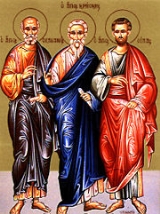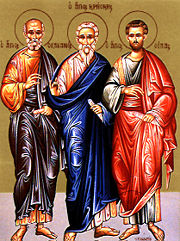
Crescens
Encyclopedia
Crescens was an individual who appears in the New Testament
. He was said to be a missionary in Galatia
and became a companion of Paul
. The name 'Crescens' is the present-active participle of the Latin
word crescere, and means 'increasing'.
 Crescens, a companion of St. Paul during his second Roman captivity, appears but once in the New Testament, when he is mentioned as having left the Apostle to go into Galatia: "Make haste to come to me quickly", St. Paul writes to Timothy, "for Demas hath left me, loving this world, and is gone to Thessalonica, Crescens into Galatia, Titus into Dalmatia" . All commentators agree in ranking Crescens with Titus
Crescens, a companion of St. Paul during his second Roman captivity, appears but once in the New Testament, when he is mentioned as having left the Apostle to go into Galatia: "Make haste to come to me quickly", St. Paul writes to Timothy, "for Demas hath left me, loving this world, and is gone to Thessalonica, Crescens into Galatia, Titus into Dalmatia" . All commentators agree in ranking Crescens with Titus
rather than with Demas, and in seeing here, therefore, a reference to a missionary journey into Galatia. This term, in New Testament times, might mean either Gaul
or the Roman province
of Galatia in Asia Minor
, where St. Paul had labored so much; and here it has been interpreted in either sense. In the other passages where it occurs in the New Testament, however, it denotes Galatia, and most probably it would be so understood here by Timothy, especially as the other regions mentioned are likewise to the east of Rome. Moreover, St. Paul might easily have a reason for sending a disciple to visit his old Churches in Galatia, while there is no proof that he had an active interest in Gaul.
Accordingly, the earliest tradition (Apostolic Constitutions
, VII, 46) represents Crescens as a bishop
of the Churches in Galatia. Later traditions, on the other hand, locate him as Bishop of Vienne in Gaul, also at Mainz
on the Rhine. But the earliest known traditions of Gaul itself record nothing of this disciple of the Apostle as a founder of their Churches, and the belief is thought to have arisen later from the desire of an Apostolic origin. The claims of Vienne have been most strongly urged; but they are based upon the mistaken identification of its first bishop, Crescens, who lived in the third century, with the disciple of St. Paul. As little can be said for Mainz. The reading of certain manuscripts (Sinaiticus
, Ephræmi), which have "Gallia" instead of "Galatia", has also been advanced in favour of Gaul; but the traditional reading is supported by the great mass of manuscript evidence. Crescens is mentioned as one of the Seventy Apostles of Christ by Pseudo-Dorotheus. His martyrdom in Galatia, under Trajan
, commemorated on 27 June by the Roman Martyrology
, lacks the confirmation of older Martyrologies. The Eastern Orthodox Church
honours him on 30 July, as one of the Seventy.
New Testament
The New Testament is the second major division of the Christian biblical canon, the first such division being the much longer Old Testament....
. He was said to be a missionary in Galatia
Galatia
Ancient Galatia was an area in the highlands of central Anatolia in modern Turkey. Galatia was named for the immigrant Gauls from Thrace , who settled here and became its ruling caste in the 3rd century BC, following the Gallic invasion of the Balkans in 279 BC. It has been called the "Gallia" of...
and became a companion of Paul
Paul of Tarsus
Paul the Apostle , also known as Saul of Tarsus, is described in the Christian New Testament as one of the most influential early Christian missionaries, with the writings ascribed to him by the church forming a considerable portion of the New Testament...
. The name 'Crescens' is the present-active participle of the Latin
Latin
Latin is an Italic language originally spoken in Latium and Ancient Rome. It, along with most European languages, is a descendant of the ancient Proto-Indo-European language. Although it is considered a dead language, a number of scholars and members of the Christian clergy speak it fluently, and...
word crescere, and means 'increasing'.

Titus
Titus , was Roman Emperor from 79 to 81. A member of the Flavian dynasty, Titus succeeded his father Vespasian upon his death, thus becoming the first Roman Emperor to come to the throne after his own father....
rather than with Demas, and in seeing here, therefore, a reference to a missionary journey into Galatia. This term, in New Testament times, might mean either Gaul
Gaul
Gaul was a region of Western Europe during the Iron Age and Roman era, encompassing present day France, Luxembourg and Belgium, most of Switzerland, the western part of Northern Italy, as well as the parts of the Netherlands and Germany on the left bank of the Rhine. The Gauls were the speakers of...
or the Roman province
Roman province
In Ancient Rome, a province was the basic, and, until the Tetrarchy , largest territorial and administrative unit of the empire's territorial possessions outside of Italy...
of Galatia in Asia Minor
Asia Minor
Asia Minor is a geographical location at the westernmost protrusion of Asia, also called Anatolia, and corresponds to the western two thirds of the Asian part of Turkey...
, where St. Paul had labored so much; and here it has been interpreted in either sense. In the other passages where it occurs in the New Testament, however, it denotes Galatia, and most probably it would be so understood here by Timothy, especially as the other regions mentioned are likewise to the east of Rome. Moreover, St. Paul might easily have a reason for sending a disciple to visit his old Churches in Galatia, while there is no proof that he had an active interest in Gaul.
Accordingly, the earliest tradition (Apostolic Constitutions
Apostolic Constitutions
The Apostolic Constitutions is a Christian collection of eight treatises which belongs to genre of the Church Orders. The work can be dated from 375 to 380 AD. The provenience is usually regarded as Syria, probably Antioch...
, VII, 46) represents Crescens as a bishop
Bishop
A bishop is an ordained or consecrated member of the Christian clergy who is generally entrusted with a position of authority and oversight. Within the Catholic Church, Eastern Orthodox, Oriental Orthodox Churches, in the Assyrian Church of the East, in the Independent Catholic Churches, and in the...
of the Churches in Galatia. Later traditions, on the other hand, locate him as Bishop of Vienne in Gaul, also at Mainz
Mainz
Mainz under the Holy Roman Empire, and previously was a Roman fort city which commanded the west bank of the Rhine and formed part of the northernmost frontier of the Roman Empire...
on the Rhine. But the earliest known traditions of Gaul itself record nothing of this disciple of the Apostle as a founder of their Churches, and the belief is thought to have arisen later from the desire of an Apostolic origin. The claims of Vienne have been most strongly urged; but they are based upon the mistaken identification of its first bishop, Crescens, who lived in the third century, with the disciple of St. Paul. As little can be said for Mainz. The reading of certain manuscripts (Sinaiticus
Codex Sinaiticus
Codex Sinaiticus is one of the four great uncial codices, an ancient, handwritten copy of the Greek Bible. It is an Alexandrian text-type manuscript written in the 4th century in uncial letters on parchment. Current scholarship considers the Codex Sinaiticus to be one of the best Greek texts of...
, Ephræmi), which have "Gallia" instead of "Galatia", has also been advanced in favour of Gaul; but the traditional reading is supported by the great mass of manuscript evidence. Crescens is mentioned as one of the Seventy Apostles of Christ by Pseudo-Dorotheus. His martyrdom in Galatia, under Trajan
Trajan
Trajan , was Roman Emperor from 98 to 117 AD. Born into a non-patrician family in the province of Hispania Baetica, in Spain Trajan rose to prominence during the reign of emperor Domitian. Serving as a legatus legionis in Hispania Tarraconensis, in Spain, in 89 Trajan supported the emperor against...
, commemorated on 27 June by the Roman Martyrology
Roman Martyrology
The Roman Martyrology is the official martyrology of the Roman Rite of the Roman Catholic Church. It provides an extensive but not exhaustive list of the saints recognized by the Church.-History:...
, lacks the confirmation of older Martyrologies. The Eastern Orthodox Church
Eastern Orthodox Church
The Orthodox Church, officially called the Orthodox Catholic Church and commonly referred to as the Eastern Orthodox Church, is the second largest Christian denomination in the world, with an estimated 300 million adherents mainly in the countries of Belarus, Bulgaria, Cyprus, Georgia, Greece,...
honours him on 30 July, as one of the Seventy.

